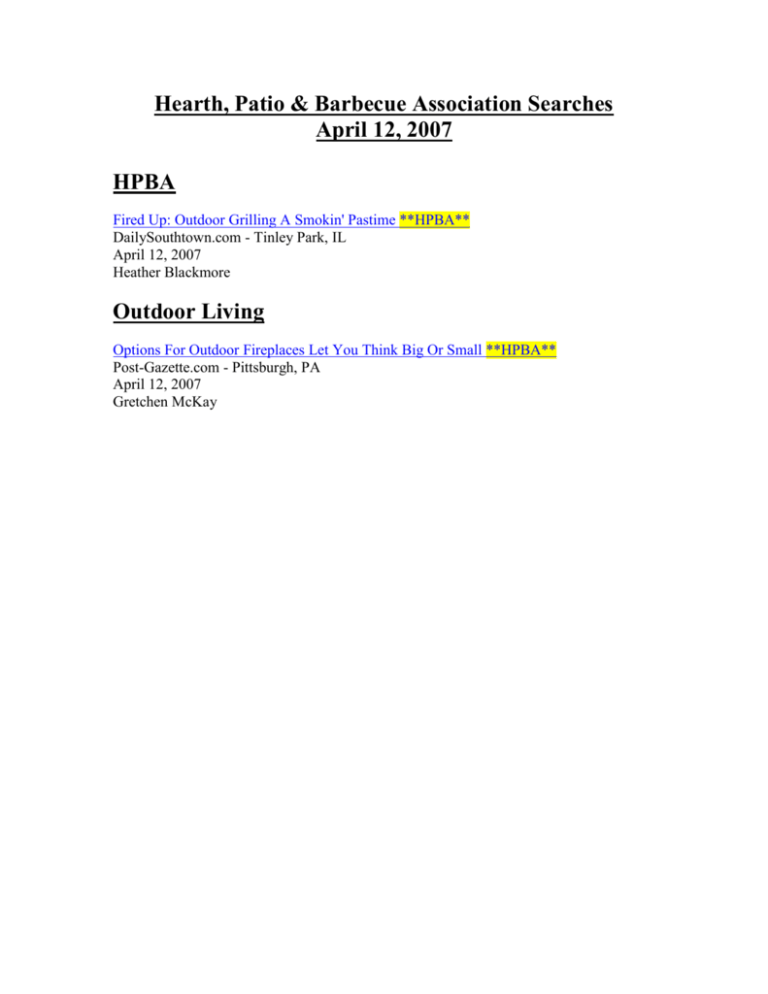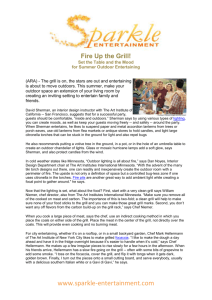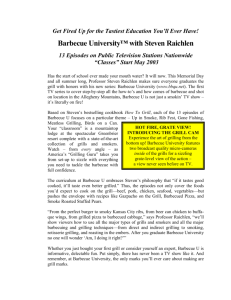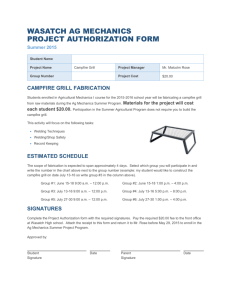Hearth, Patio & Barbecue Association Searches
advertisement

Hearth, Patio & Barbecue Association Searches April 12, 2007 HPBA Fired Up: Outdoor Grilling A Smokin' Pastime **HPBA** DailySouthtown.com - Tinley Park, IL April 12, 2007 Heather Blackmore Outdoor Living Options For Outdoor Fireplaces Let You Think Big Or Small **HPBA** Post-Gazette.com - Pittsburgh, PA April 12, 2007 Gretchen McKay Options For Outdoor Fireplaces Let You Think Big Or Small **HPBA** Post-Gazette.com - Pittsburgh, PA April 12, 2007 Gretchen McKay The Cal Flame FRP-4100 outdoor fireplace has an L-shaped design and extended arms for spacious bench seating. Options include LED lighting and a waterfall. There's nothing like a fire pit or chimenea to add a little warmth and ambience to a backyard garden or patio. But even the most elaborate models can only go so far in terms of cranking out the heat and creating a focal point. If you really want to bring the comforts of indoor living to the outdoors, and in the process extend the season, your best bet is an outdoor fireplace. A hearth is one of the three mainstays of the outdoor living room, according to the Hearth, Patio & Barbecue Association (the other two are a grill and a table). Today, there are more choices than ever in outdoor fireplaces. And unlike in the past, when homeowners would have had to hire a landscaping contractor or stone mason to create one from scratch, many are moderately priced, prefabricated models that can easily be installed by the homeowner. The Mirage Stone fireplace ($1,499-$1,799) offered by warehouse chain Costco, for example, looks like stone but is actually made from a high-temperature refractory cement that is lighter and stronger than traditional concrete. Its interlocking construction (firsttime installers can assemble its 44 pieces in about an hour) means there's no mortar, glue or fasteners to deteriorate in the elements. It burns wood, charcoal or natural or propane gas and comes with a three-position adjustable grill. Home Depot sells three different wood-burning outdoor fireplaces. The Deluxe Classic Stone House fireplace ($459) stands just over 5 feet and has a cultured stone roof and base and a granite pedestal on which to place logs. The 3 1/2-foot Terrazzo fireplace ($799) looks more like a traditional fireplace, with a single large hearth and terrazzo tile decoration. A more upscale stainless steel and stucco piece, crafted by Bull Outdoor Grill Products, is bigger still, with a 42-inch fireplace insert and 8-foot tall chimney. It costs $3,200, and like the other two, is available only through the Internet/catalog. DBG's exterior gas fireplaces offer even higher style, and are just as easy to install. Made from a lightweight exterior concrete and available in five color options, the prefabricated units are designed to go through a garden gate and can be installed by two people -- you simply stack and bolt them together. The California-based company offers six styles ranging from 39 to 95 inches in height and from $2,650 to $5,700 in price. One of the most popular models, the 84-inch Petite Coronado ($3,250), has four different hearths, including a 16-inch- radius bullnose. Cal Fire's Tropical Senses (FRP-4300) fireplace ($3,683), available in 11 stucco colors, is more contemporary. It features a sturdy rectangular-shaped hearth that's topped by a graceful archway highlighted by solar-powered LED accent lighting. Other options include a fully integrated stereo with four embedded 6 1/2-inch all-weather speakers, and an iPod docking station. The L-shaped FRP-4100 fireplace, available in more than two dozen coordinating stuccos and tiles, has extended arms for bench seating and an accented chimney stack. It costs $6,639. Vermont-based Hearthlink International's Nexo masonry outdoor fireplaces might look custom-built, but they're actually a modular product. The four pieces "go together like a puzzle," according to company managing director John King. Faced with natural sandstone or stucco, these giant chimenea-like units are designed and manufactured in Denmark and include an inner firebox constructed of volcanic pumice stone so as to withstand intense heat. The Cape Cod corner model (about $2,000) stands 83 inches tall and has a 33-inch hearth. Or maybe you prefer a fireplace just like the one you have indoors. If so, any number of companies sell fireboxes that can be enclosed in a wood or masonry surround. (If the unit is powered by gas, you will also have to run a gas line under the patio.) Heat-N-Glo, Lennox Hearth Products, Rumford, Vermont Castings and Napoleon Fireplaces are just a few that have fireplaces specifically designed for outdoors, with prices starting at about $1,800; a few also offer them already finished in tile or stucco. Heat-N-Glo's stainless-steel Dakota ($2,799), for example, can be ordered with an optional three-piece, tile-and-stucco Outdoor Elements surround. Whatever you choose, don't underestimate the amount of space some of the bigger fireplaces will take up on your patio, as well as how much stress they can put on the surface. It's not unusual for a stone or brick fireplace to weigh 1,000 pounds or more -and that's all concentrated in one spot. Fired Up: Outdoor Grilling A Smokin' Pastime **HPBA** DailySouthtown.com - Tinley Park, IL April 12, 2007 Heather Blackmore Outdoor grilling no longer is just a summertime pleasure. Year-round use has become the rule. Homeowners have extended their living spaces into "outdoor rooms." Just as the kitchen is the heart of the home, the grill is the heart of the outdoor room, and consumers are not afraid to brave the elements to attain that barbecue flavor. Still, many Chicago-area residents not brave enough to grill during winter soon will be pulling their grills out of dry dock and gearing up for the summer searing season. Grilling has become so big that a record 17 million grills were shipped to consumers in 2006, a 15 percent increase from the previous year, according to statistics from the Hearth, Patio and Barbecue Association. Grilling suits the fast-paced lifestyle of many American households simply because it's an easy, efficient and tasty alternative to indoor cooking. Clean-up is a breeze. The No. 1 grill "utensil" is aluminum foil. From fish to fowl, beef to pork, nothing can infuse food with flavor like the grill. Garold Allen grills every chance he gets, because, as he says, "It just makes food taste better." The Homer Glen resident bought the biggest six-burner gas grill he could afford, simply because of its efficiency when large crowds gather at his home to relish his signature pork roast. His crab-and-cheese-stuffed portabella mushrooms are another favorite among his tailgating crowd. The grill also allows Allen to experiment with different flavor combinations to achieve what he hopes will please his family and friends. "I don't have any fancy recipes; I just like to experiment," he said. "If it turns out good, then we'll have it again." He gets plenty of practice. He fires up the grill at least four times a week, as long as the temperature does not dip below 30 degrees. "People want to be outside," said Deidra Darsa, public relations and media manager for the Hearth, Patio and Barbecue Association. "Today, you have the grill or cooking area, sinks, dishwashers, prep areas and refrigerators outside. It's wild. Who needs a house anymore?" According to Karl Marsh, executive chef for Omaha Steaks, with a location in Orland Park, grilling is becoming a way of life for people who want to improve their culinary repertoire. He says family men are stepping up and helping with food preparation responsibilities. And the grill has become their domain. "Twenty years ago, the lady of the house would go out and do the grilling," he said. "That's not to say that they can't do it better than men now. I think in most cases women are probably better grillers." Regardless of talent, good barbecue starts with good food, he says. An inferior cut of meat -- such as a steak sliced less than an inch thick or one with little marbling -- will make for a less-than-perfect finished product. Maintaining grill temperature is crucial. In the colder months, it's important to monitor the temperature because it takes twice as long to heat up than it would in the summer months. For example, Marsh allows 40 minutes for his grill to reach the right temperature in February. Typically, 20 minutes is all that is necessary in warmer weather. A grill at the right temperature creates a better sear on the meat. "The type of grill really depends on personal preference," he said. "Gas grills are easier to deal with in the winter because you're not going to be standing out there trying to get it lit in the winter wind." The only downfall of the gas grill occurs when it's new. "Seasoned" grills have a carbon build-up on the grate, a result of frequent use. The build-up intensifies the flavor and gives it that authentic barbecue taste common among charcoal grills. Grill selection is all about personal preference. Will it be a centerpiece in an outdoor room? A high-tech appliance with all the bells and whistles? Or just another kitchen amenity? Consumers are putting a lot of thought into how the grill will fit into the outdoor living plan. From traditional charcoal to gourmet gas models, there's a grill suited to every taste and budget. The Hearth, Patio and Barbecue Association recommends a grill with 400 square inches of cooking space or more. But one certainly can be smaller if space is limited. Stainless steel is the most durable of all the finishes, because it stands up to the elements. It also comes with the heftiest price tag: $5,000 for a top-of-the-line model. Color also is option as homeowners design their living spaces around the cooking station. Darsa says homebuilders are including outdoor grilling options in new construction. Whether it's a high-end grill or a tiny hibachi, the perfect steak always is within reach, rain or shine. "More and more people are drawn to the outdoor living trend," Darsa said. "The grill simply expands on the outdoor experience."







